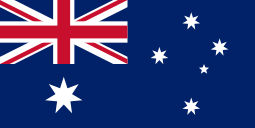 | |
| Use | National flag and state ensign |
|---|---|
| Proportion | 1:2 |
| Adopted |
|
| Design | A Blue Ensign defaced with the Commonwealth Star in the lower hoist quarter and the five stars of the Southern Cross in the fly half. |
| Designed by | Annie Dorrington, Ivor Evans, Lesley Hawkins, Egbert Nutall and William Stevens |
| This article is part of a series on the |
| Culture of Australia |
|---|
 |
| Society |
| Arts and literature |
| Other |
| Symbols |
|
Australia portal |
The national flag of Australia is based on the British Blue Ensign—a blue field with the Union Jack in the upper hoist quarter—augmented with a large white seven-pointed star (the Commonwealth Star) and a representation of the Southern Cross constellation, made up of five white stars (one small five-pointed star and four, larger, seven-pointed stars). Australia also has a number of other official flags representing its people and government bodies.
The original version of the flag first flew as the Commonwealth blue ensign on 3 September 1901, after being selected alongside a red version (the Red Ensign) in a competition held following Federation. A slightly simplified version as approved by King Edward VII was officially adopted in 1903. It was later modified to the current design on 8 December 1908, with the change from a six- to a seven-point Commonwealth Star. In 1954, the flag was recognised in legislation with the passage of the Flags Act 1953. This act also ended the confusion since 1901 as to whether the red ensign or the blue ensign was to be used, with the blue ensign designated as the Australian National Flag and given priority for the first time over the Union Jack.
- ^ Commonwealth of Australia Gazette No. 8, 20 February 1903
- ^ "Commonwealth of Australia Gazette 1908 No. 65". Australian Government Federal Register of Legislation. 19 December 1908. p. 1709. Retrieved 25 January 2019.